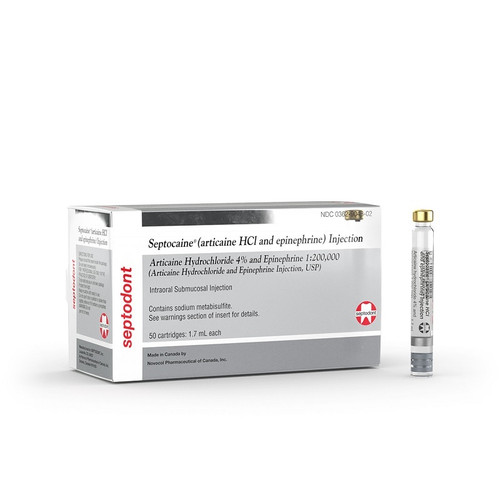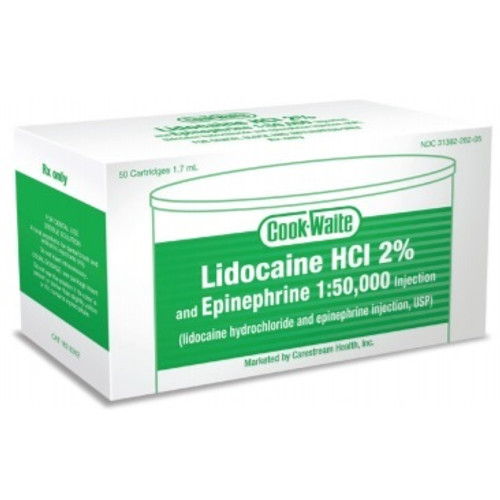- Septocaine is a dental anesthetic containing 4% articaine HCl and epinephrine 1:200,000
- It is the most common formulation of Septocaine, intended for most routine dental procedures
- This product is for prescription use only and can only be purchased by licensed dental or medical professionals
Uses and effectiveness
- Anesthetic purpose:
- Septocaine is an amide-type local anesthetic used for local, infiltrative, or conductive anesthesia
- It works by blocking nerve impulses in the mouth and is used in a variety of dental procedures
- Speed of action:
- The onset of numbness is fast, occurring within 1 to 9 minutes of injection
- Duration of effect:
Infiltration injections:
Provides up to 60 minutes of anesthesia
Nerve blocks:
Can provide up to 120 minutes of anesthesia
Key product features
- Latex-free:
- All components are 100% latex-free to reduce the risk of allergic reactions
- No methylparaben:
- The formulation is free of methylparaben, which can cause allergic reactions in sensitive patients
- Terminal sterilization:
- The cartridges are terminally sterilized for safe use
- Cartridge safety:
- The glass cartridges are covered with a Mylar label to minimize the risk of injury if a cartridge breaks
Important warnings and contraindications
- Sulfite allergy:
- Septocaine is contraindicated in patients with a known hypersensitivity to sulfites due to the presence of sodium metabisulfite
- Sulfites can cause allergic reactions, particularly in people with asthma
- A sulfite allergy is distinct from a sulfa drug allergy
- Accidental injection:
- Accidental intravascular injection is a serious risk that can lead to convulsions, coma, or respiratory arrest
- Dentists must aspirate before injection to prevent this
- Methemoglobinemia:
- Like other local anesthetics, articaine can cause methemoglobinemia, a rare blood disorder
- This risk is higher in infants under 6 months old and people with certain genetic conditions
- Nervous and cardiovascular systems:
- High plasma levels of articaine can affect the nervous and cardiovascular systems
- Patients should be monitored constantly for signs of toxicity like confusion, tremors, or an irregular heart rate
- Vasoconstrictor toxicity:
- The epinephrine in Septocaine can cause local tissue injury or systemic toxicity
- This should be used cautiously in patients with cardiovascular issues
Common side effects
- Common, typically less severe side effects may include:
- Headache
- Pain at the injection site
- Nausea and vomiting
- Swelling
- Numbness and tingling
Drug interactions
- Patients should inform their dentist if they are taking:
- Monoamine oxidase inhibitors (MAOIs)
- Tricyclic antidepressants
- Nonselective beta-adrenergic antagonists
Pediatric use
- The safety and effectiveness of Septocaine have been established for pediatric patients between 4 and 16 years of age. Use is not recommended for children under 4.
Contents:
- 1.7mL Cartridge size
- 50 Cartridges per box







